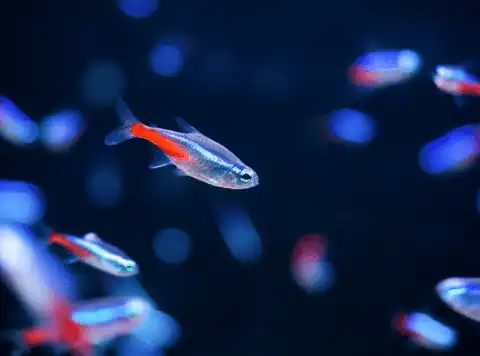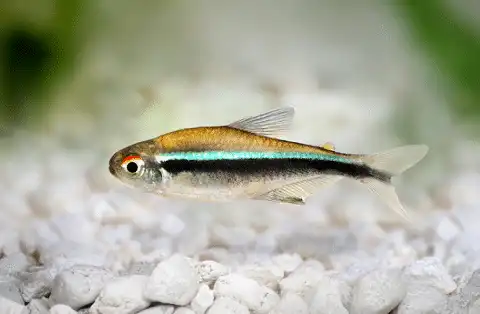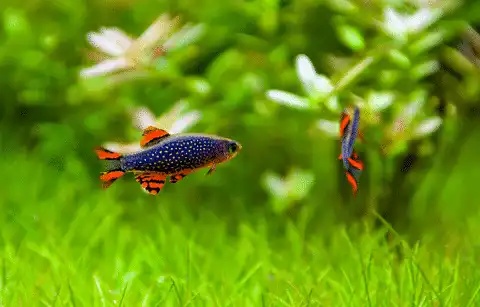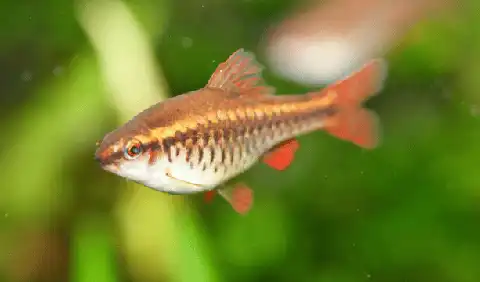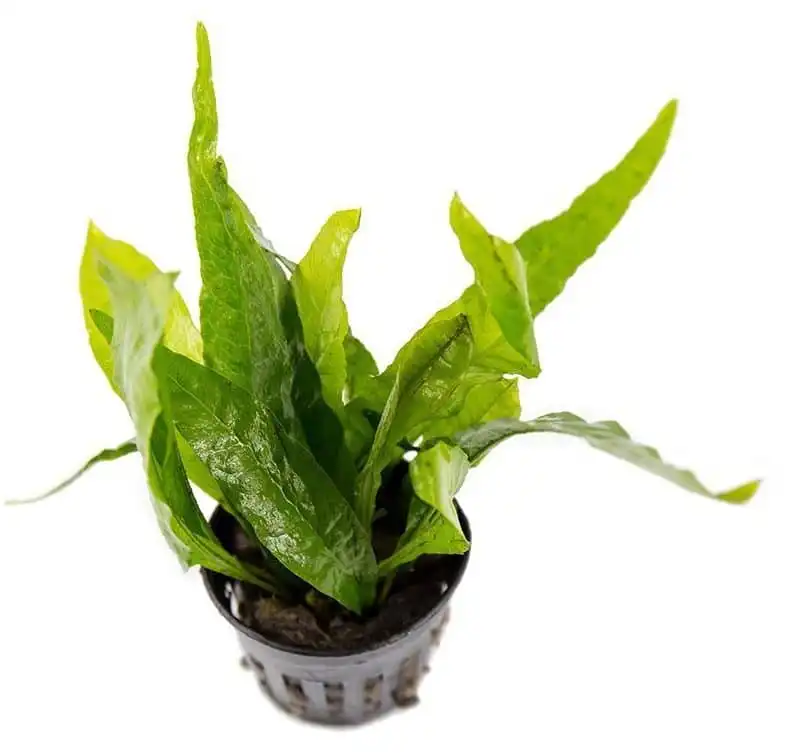Thank you for visiting! By the way… any links on this page that lead to products on Amazon and other stores/partners are affiliate links Aquarium Store Depot earns a commission if you make a purchase.
Are you looking for some great new friends for your neon tetras? These colorful fish are one of the best community species in the aquarium hobby because of their peaceful and easy-going nature. Choosing the perfect tank mates for your fish can be stressful, and that’s exactly why I’ve written this article.
Read along for some great neon tetra tank mates and loads of other useful tips. Let’s get started!
Key Takeaways
- Neon tetras need to be kept in a group to thrive. Six should be the bare minimum, but ten or more is a better choice.
- You can mix different species of neon tetras – just make sure you have enough of each species to form their own schools.
- Avoid any tank mates that are large enough to eat neon tetras.
- Neon tetras prefer acidic to neutral water. Avoid tank mates that need hard, alkaline water.
Choosing NEON TETRA Tank Mates – A Word Of Caution
Neon tetras get along with loads of other tropical fish, but there are just as many species that don’t make good tank mates. So how do you choose?
Size
Neon Tetras are very small fish with a maximum size of about 1.25 inches. At this size, many larger fish can (and will) swallow them whole!
Most popular aquarium species are omnivorous or carnivorous fish, so choosing similar-sized tank mates is always a good idea. There are exceptions, but most fish that grow over 3 or 4 inches will be risky.
Neon tetras can be housed in tanks as small as 10 gallons on their own, but bigger is better if you want to keep more than one species. 15 gallons will work, but 20+ is a better bet when setting up a community tank.
Group Size
Group or school size is another important factor to consider when choosing neon tetra tank mates.
You will notice that the fish species in this article are small, up to 2 inches. Fish of that size might not need very much room, but these species are social creatures that need to be kept with their own kind to behave confidently.
Parameters
Neon tetras prefer slightly cooler water than most other tropical fish. They also enjoy mildly acidic water. These are important factors when choosing tank mates because some fish need colder or warmer conditions or water with a higher pH.
Let’s take a look at the ideal parameters for your neon tetras:
- Water Temperature: 68 – 78 °F
- pH: 5 – 7
- Hardness: 18 – 215 ppm
- Flow: Low to Moderate
Temperament
Neon tetras are peaceful fish, and they need peaceful tank mates. Avoid territorial fish or species that are known to be aggressive or nip fins. Be aware that even peaceful fish can behave badly if they are not kept in groups or if they are under stress.
Swimming Level
It’s a good idea to add fish that occupy various levels in the water column. This article focuses on colorful schooling and shoaling fish, but adding a few bottom feeders will help to keep your tank clean while adding another layer of movement.
Top 15 Companions
Now that you know what to look for in the perfect neon tetra tank mate let’s jump in and meet 15 amazing species you can add to your fish tank. Take note of the following facts and guidelines for each species:
- Scientific Name
- Adult Size
- Care Level
- Temperament
- Swimming Level
- Minimum Tank Size
- pH
- Water Temperature
Let’s get started!
1. Other Types
Use Promo Code ASDFLIPPROMO
One of the most popular freshwater community schooling fish available in the aquarium trade. Great neon blue colors!
- Scientific Name: Paracheirodon innesi
- Adult Size: 1.25 inches
- Care Level: Easy
- Temperament: Peaceful
- Swimming Level: Middle
- Minimum Tank Size: 10 gallons
- pH: 5 -7
- Water Temperature: 68 – 78 °F
Sometimes, the best tank mates for neon tetras are other neon tetras! These peaceful tropical fish are very social creatures that live in large schools in their natural habitat.
There is no limit to the number of neon tetras you can keep if you have enough room, but you should keep a minimum of 6. Like other schooling aquarium fish, your neon tetras just won’t be comfortable without the company of their own species.
2. Black
A variant neon variety. More reliant than neon and cardinal tetras
- Scientific Name: Hyphessobrycon herbertaxelrodi
- Adult Size: 1.5 inches
- Care Level: Easy
- Temperament: Peaceful
- Swimming Level: Mid/ top-water
- Minimum Tank Size: 15 gallons
- pH: 5 – 7.5
- Water Temperature: 72 – 77 °F
Black neon tetras are a different species from regular neon tetras, but they have very similar behavior. Their bold black, silver, and red colors contrast with the blues of the neon tetras for an amazing display.
Black neon tetras are true community fish. They grow slightly larger than regular neon tetras, but you can easily keep a small school of both species in a 15-gallon tank with good filtration and plenty of swimming space.
3. Green

- Scientific Name: Paracheirodon simulans
- Adult Size: 0.75 – 1 inch
- Care Level: Easy
- Temperament: Peaceful
- Swimming Level: Mid/ top-water
- Minimum Tank Size: 10 gallons
- pH: 5 – 6.5
- Water Temperature: 76 – 95 °F
The green neon tetra is very similar to the regular neon, but it stays a little smaller. These little fish have even brighter blue and green coloration but have less red than regular neon tetras.
Green neons can make great neon tetra tank mates, but they prefer warmer water. That means the two species must be kept right around 77°F to keep everyone happy.
4. Dwarf Rasbora
- Scientific Name: Boraras maculatus
- Adult Size: 0.75 – 1 inch
- Care Level: Moderate
- Temperament: Peaceful
- Swimming Level: Mid/ top-water
- Minimum Tank Size: 10 gallons
- pH: 5 – 6.5
- Water Temperature: 68 – 82 °F
The dwarf rasbora (video resource) is a tiny fish from Southeast Asia. They are very peaceful fish that will thrive in a well-maintained community tank with neon tetras and other smaller fish.
The dwarf rasbora is a good tank mate for a heavily planted aquarium. These fish can thrive in a small tank, but maintaining excellent water quality in a low volume of water is best left to more experienced aquarists.
5. Exclamation Point Rasbora
One of the smallest fish available in the hobby. Best in schools and easy to care for
- Scientific Name: Boraras urophthalmoides
- Adult Size: 0.5 – 0.75 inches
- Care Level: Moderate
- Temperament: Peaceful
- Swimming Level: Mid/ lower levels
- Minimum Tank Size: 10 gallons
- pH: 6 – 7
- Water Temperature: 68 – 82 °F
The exclamation point rasbora is a true nano fish and one of the smallest freshwater fish in the aquarium hobby! These tiny schooling fish get their name from the dot and stripes on the sides of their body.
Exclamation point rasboras are good neon tetra tank mates in a heavily planted aquascape. They are ideal for more advanced aquarists looking for a nano community fish.
6. Harlequin Rasbora
A peaceful schooling fish. An ideal community fish. A great beginner fish
- Scientific Name: Trigonostigma heteromorpha
- Adult Size: 1.5 – 1.75 inches
- Care Level: Easy
- Temperament: Peaceful
- Swimming Level: Mid/ top-water
- Minimum Tank Size: 15 gallons
- pH: 5 – 7.5
- Water Temperature: 70 – 82°F
Looking for a hardy fish with great color and personality for your neon tetra community tank? Look no further than the harlequin rasbora! These beautiful fish make quite a statement with their bold black triangular markings.
Harlequin rasboras will get along great with your neon tetras, but it’s very important to keep them with other fish of their own species. Pick up a group of at least 8 of these active fish.
7. Celestial Pearl Danio
A great-looking danio fish. Males are more colorful than females. A midway dwelling fish
- Scientific Name: Celestichthys margaritatus
- Adult Size: 0.75 inches
- Care Level: Moderate
- Temperament: Peaceful
- Swimming Level: Mid/ lower levels
- Minimum Tank Size: 10 gallons
- pH: 6.5 – 7.5
- Water Temperature: 68 – 78°F
Celestial pearl danios (AKA galaxy rasboras) are very suitable tank mates for neon tetras in a well-maintained home aquarium. These little fish are very peaceful, but they are easily outcompeted for food by larger active swimmers, so choose their tank mates carefully.
You will love the way these shoaling fish hang out and display for each other. They are not exactly coldwater fish, but they enjoy the same cooler water temperatures as neon tetras.
8. Cherry Barbs
- Scientific Name: Puntius titteya
- Adult Size: 1.75 – 2 inches
- Care Level: Easy
- Temperament: Peaceful
- Swimming Level: Mid/ top-water
- Minimum Tank Size: 15 gallons
- pH: 6 – 8
- Water Temperature: 68 – 80 °F
Cherry barbs are a great nano community fish from the same family as goldfish. They are a very peaceful barb species that won’t bother your neon tetras.
These schooling fish come from forest streams in Asia, and they thrive in community tanks with other peaceful schooling fish.
Cherry barbs are very active swimmers, and they need the company of their own species to feel comfortable. Keep a group of at least 6 in a tank with plenty of swimming space, and you’ll find that they make great tank mates for your neon tetras!
9. Dwarf Gourami

- Scientific Name: Trichogaster lalius
- Adult Size: 3 inches
- Care Level: Moderate
- Temperament: Peaceful
- Swimming Level: All levels
- Minimum Tank Size: 15 gallons
- pH: 6 – 7.5
- Water Temperature: 72 – 80°F
Dwarf Gouramis are active and curious fish that enjoy exploring their aquarium. These fascinating fish breathe air at the surface of the tank, so keep that in mind if you plan on growing floating plants.
The male dwarf gourami is a very colorful fish with iridescent blues, reds, and silvers – just like your neon tetras! These fish should be kept in pairs or small groups.
10. Honey Gourami
One of the more peaceful Gourami fish available in the hobby. Has a unique yellow coloration and only grows up to 2 inches in length
- Scientific Name: Trichogaster chuna
- Adult Size: 2 inches
- Care Level: Moderate
- Temperament: Peaceful
- Swimming Level: All levels
- Minimum Tank Size: 15 gallons
- pH: 6 – 7.5
- Water Temperature: 72 – 80 °F
The honey gourami is similar to the dwarf gourami but stays even small at around 2 inches. These peaceful tropical fish will brighten up your aquarium with their beautiful golden color.
Honey gouramis are easy to care for, so they make a great choice for beginner fish keepers looking for a new species with an interesting shape and calm personality. You can keep a pair of these fish in a tank of 15 gallons but jump up to 20 gallons or more if you want a small group.
11. Sparkling Gourami
Sparkling gouramis (video source) are also known as pygmy gouramis. They are one of the smallest gourami species in the aquarium hobby, and they are a great choice for your neon tetra tank.
They are more streamlined than other gouramis, and their large fins and bright blue eyes really make them stand out in a tropical community. Sparkling gouramis are not exactly schooling fish, but they prefer to be kept in a group with their own species.
12. Amano Shrimp
Best For Planted Tanks!
When it comes to keeping a healthy planted aquarium, Amano Shrimp are the best. These hard-working crustaceans will dutifully wipe your plants and rockwork clean of algae. Their appetite for different types of algae that can't be matched by other shrimp breeds!
- Scientific Name: Caridina multidentata
- Adult Size: 2 inches
- Care Level: Moderate
- Temperament: Peaceful
- Swimming Level: Bottom
- Minimum Tank Size: 10 gallons
- pH: 6 – 7.6
- Water Temperature: 60 – 80°F
Amano shrimp are one of the larger freshwater shrimp species in the aquarium hobby. These shrimp are named after Takashi Amano, the legendary aquarist and photographer.
Amano Shrimp are amazing algae eaters, which makes them the perfect choice for planted aquariums. They may not be the most colorful inverts, but they are fascinating to watch.
Adults are generally safe with neon tetras and other small fish, but shrimplets can be risky. Providing plenty of hiding spaces and dense plants like Java moss will give them a safe place to hang out until they are large enough to explore.
13. Cherry Shrimp
Great red color and very hardy. Cherry shrimp are the best beginner shrimp for shrimp tanks
- Scientific Name: Neocaridina davidi
- Adult Size: 1.25 – 1.5 inches
- Care Level: Easy
- Temperament: Peaceful
- Swimming Level: Bottom
- Minimum Tank Size: 5 gallons
- pH: 6.8 – 7.5
- Water Temperature: 65 – 80 °F
Cherry shrimp are popular, hardy, and affordable freshwater shrimp that can be great neon tetra tank mates. These bottom feeders eat algae and other waste, which makes them a natural choice for your clean-up crew!
Adult cherry shrimp are usually safe to keep with neon tetras, but the babies will be eaten if they don’t have plenty of hiding places like caves and fine-leaved plants. You may wish to add a few inexpensive ghost shrimp first to see if your fish are going to be shrimp-safe.
14. Nerite Snail
Horned Nerite Snails are excellent algae eaters for planted tanks.
- Scientific Name: Neritina spp.
- Adult Size: 1- 1.5 inches
- Care Level: Easy
- Temperament: Peaceful
- Swimming Level: Bottom
- Minimum Tank Size: 5 gallons
- pH: 6.5 – 8.5
- Water Temperature: 65 – 85 °F
Nerite snails are beautiful and hardworking members of your clean-up crew. These colorful creatures cruise around on the leaves of plants and your aquarium glass, slowly grazing on algae to keep your tank looking great.
Nerite snails do not breed in freshwater, so you don’t have to worry about them multiplying in your tank. Many amazing species are available in the aquarium trade, with zebra and tiger nerites being the most popular.
15. Mystery Snails
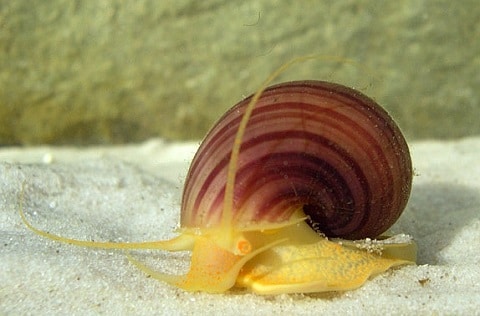
- Scientific Name: Pomacea bridgesii
- Adult Size: 2 inches
- Care Level: Easy
- Temperament: Peaceful
- Swimming Level: Bottom
- Minimum Tank Size: 5 gallons
- pH: 7 – 8.4
- Water Temperature: 68 – 82°F
Mystery snails are another great invertebrate option for your neon tetra tank. These large snails come in a variety of colors, including white, golden, purple, and blue.
These snails lay their eggs outside of the water, so you don’t have to worry about them breeding if you keep your tank full. Mystery snails can be kept with neon tetras if you have water right around neutral but they do not thrive in low-pH conditions.
Other Possibilities
Want even more neon tetra tank mate ideas? These fish are also potential choices:
Fish To Avoid
Now that we’ve covered a bunch of great neon tetra tank mates let’s take a look at some of the tank mates you should avoid.
Most of the fish listed above are examples of larger fish that can eat your neon tetras. Avoid fish that grow larger than about 3 inches to stay on the safe side.
Betta fish aren’t going to eat neon tetras, but they can be a little aggressive toward them. The least risky will be female bettas. Other small aggressive fish like tiger barbs and silvertip tetras should also be avoided as well as any species that require water temperatures above 78 °F or a pH above 7.
Community Tank Tips
Have you chosen your favorite neon tetra tank mates? Before you go out and order your new fish, take a few minutes to read through these handy neon tetra tank tips!
Tank Size
You can keep neon tetras in a tank of just 10 gallons, but your options are pretty limited. I would suggest a tank of at least 15 gallons, but 20 gallons or more is advisable. Remember, neon tetras are schooling fish, so you’re going to want at least 6.
If you add some other schooling aquarium fish like harlequin rasboras, your total stocking will increase to at least 14 fish.
Bigger is (almost) always better when setting up a community tank, so keep this in mind if you don’t already have your aquarium set up.
Filtration, Lighting & Heating
A successful neon community tank requires good filtration, a reliable aquarium heater, and six to eight hours of lighting each day.
Neon tetras do not mind a decent flow rate in their tank since they live in rivers in their natural environment. Nevertheless, they are small fish that will become stressed if forced to swim against a strong current all day.
Decorating Your Tank
Your Neon Tetras will enjoy plenty of swimming space, but they prefer to have some structure in their home. Add some driftwood and rocks to create a more natural habitat.
Growing live plants in your aquarium is a great way to improve your water quality and make your tank even more beautiful.
Choose easy plants like Java ferns and Amazon sword if you’re just starting out. These plants don’t need any specialized equipment to thrive.
Java Fern is one of the easiest and hardiest live plants you can purchase
Feeding Your Fish
Neon tetras are very easy to feed. Providing high-quality flake food once or twice each day will keep them happy and healthy. Provide the occasional treat like live or frozen bloodworms and brine shrimp to keep your fish in top condition.
Overfeeding your fish is a common mistake that can have some surprisingly serious consequences. Watch your fish eat; they should be able to finish their food in a minute or so.
Tank Maintenance
Maintaining a healthy neon tetra community tank takes a little regular maintenance.
Schedule an hour or so each week to perform regular water changes and tank maintenance. I recommend testing your water every week to monitor the build-up of nitrates and phosphates.
You can plan your maintenance schedule around the results of your tests and aim to keep your nitrate levels down to about 20 parts per million or less. You’ll also want to clean your glass and ornaments from time to time and rinse out your filter media when it begins to clog up.
However, there are some things you can do to minimize the amount of maintenance you need to do. Use these tips to keep your tank cleaner for longer:
- Avoid overstocking your tank. More fish means more food and more fish poop!
- Grow live plants
- Use high-quality filtration
- Avoid overfeeding
- Add clean-up crew animals like nerite snails and cherry shrimps
Where To Buy
Are you ready to get some new friends for your neon tetras? You should have no trouble tracking down the species in this list. Most local fish stores will stock these fish; just make sure to buy from stores that take great care of their animals.
More and more aquarists are buying their fish online these days. You can also consider ordering your fish from a trusted online retailer and having them delivered directly to your door!
FAQs
Are They Good Companions?
Neon tetras make wonderful tank mates for many other fish. These peaceful fish are safe to keep with similar-sized tropical fish that enjoy the same water parameters.
How Many Can I Put In A 10-gallon Tank?
A school of 6 neon tetras is a good option for a 10-gallon aquarium with good filtration. It is easy to overstock a small aquarium, but remember that these fish need to be kept in a school.
Do All Tetra Fish Get Along?
Most tetras are very peaceful fish, but some can be a little bit nippy. Serpae tetras and silvertip tetras are two species that can be aggressive towards other fish and their own species.
Do Tetra Fish Need Companions?
Tetra fish absolutely need the companionship of their own species. That means you need at least 6 neon tetras together in the same tank. Six different species of tetras, or two groups of three, will not school together in the same way.
What Fish Gets Along With Tetras?
Most small, peaceful tropical fish get along with tetras. Small schooling fish like rasboras, gouramis, and other species like cardinal tetras are all great options for the middle levels of the water column. Small bottom feeders like cory catfish and even African dwarf frogs also make excellent tank mates.
Can 4 Of Them Live Together?
Try to keep at least 6 neon tetras together in your tank. These fish live in huge schools in nature where they enjoy the benefits of safety in numbers. They may be shy and nervous in a group of four.
What Big Fish Can Live With Them?
Most big fish will eat your neon tetras, but a few vegetarian species are pretty safe. Plecos are one of the few large fish that are safe to keep with tetras.
How Many Should Be Kept Together?
Neon tetras are social schooling fish who are shy and nervous. They should be kept in schools of at least 6, although 12 or more is even better.
Final Thoughts
Use the tips in this guide to help you choose your next tank mates. Remember, choose peaceful, similar-size fish that enjoy the same water parameters as your neon tetras. Give them plenty of swimming space and keep their tank clean for a happy and healthy home aquarium!
What is your favorite neon tetra tank mate? Let us know in the comments below!
- About the Author
- Latest Posts
I’m thrilled that you found Aquarium Store Depot! Here you’ll find information on fish, aquariums, and all things aquatics related. I’m a hobbyist (being doing this since I was 11) and here to help other hobbyists thrive with their aquariums! I adhere to a high quality Editorial Process and Review products with real life field usage and practical analysis.


